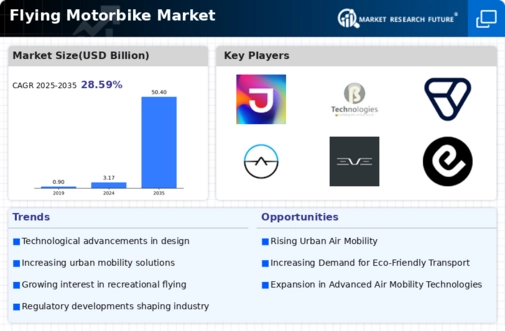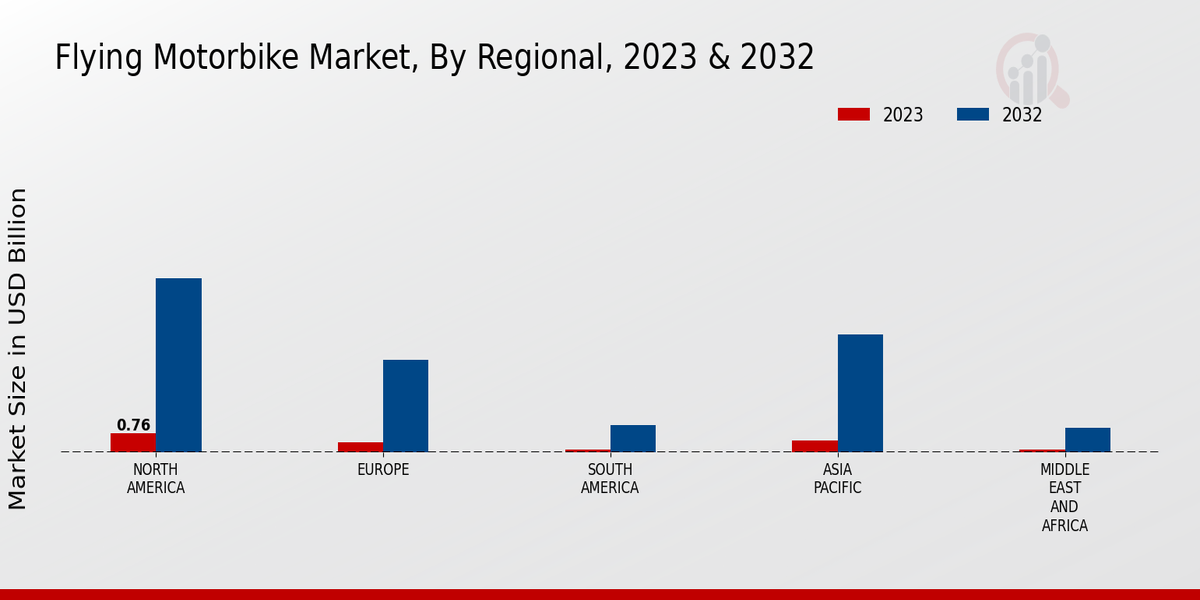Environmental Concerns
Growing environmental concerns are influencing the Global Flying Motorbike Market Industry as consumers and governments alike seek sustainable transportation options. Flying motorbikes, particularly those powered by electric propulsion, are perceived as a cleaner alternative to conventional vehicles. This shift towards eco-friendly transportation is prompting manufacturers to invest in green technologies, which may enhance their market appeal. As environmental regulations tighten globally, the demand for low-emission vehicles is likely to rise, positioning flying motorbikes as a viable option. This trend could significantly impact market dynamics, encouraging innovation and investment in sustainable practices.
Investment and Funding
The Global Flying Motorbike Market Industry is witnessing increased investment and funding from both private and public sectors. Venture capitalists and government initiatives are channeling resources into the development of flying motorbikes, recognizing their potential to revolutionize personal transportation. This influx of capital is fostering innovation and accelerating the commercialization of flying motorbikes. As more companies enter the market, competition is expected to intensify, driving technological advancements and reducing costs. This financial backing is crucial for the industry's growth trajectory, as it supports research and development efforts that could lead to more efficient and affordable flying motorbikes.
Urban Mobility Solutions
The Global Flying Motorbike Market Industry is increasingly viewed as a solution to urban mobility challenges. As cities become more congested, flying motorbikes offer a potential alternative to traditional ground transportation. They can bypass traffic jams and reduce travel time significantly, appealing to urban commuters. Governments are exploring regulations and infrastructure to support this mode of transport, which may further stimulate market growth. The integration of flying motorbikes into urban transport systems could lead to a transformative shift in how people navigate cities, thereby enhancing the industry's attractiveness and potential market size.
Market Growth Projections
The Global Flying Motorbike Market Industry is projected to experience substantial growth over the coming years. With an estimated market value of 3.17 USD Billion in 2024, the industry is expected to expand rapidly, potentially reaching 50.4 USD Billion by 2035. This growth trajectory suggests a compound annual growth rate of 28.59% from 2025 to 2035. Such projections indicate a burgeoning interest in flying motorbikes as viable transportation solutions, driven by technological advancements, urban mobility needs, and environmental considerations. The anticipated market growth underscores the potential for flying motorbikes to become a mainstream mode of transport in the near future.
Technological Advancements
The Global Flying Motorbike Market Industry is experiencing rapid technological advancements that enhance the feasibility and safety of flying motorbikes. Innovations in electric propulsion systems, lightweight materials, and autonomous navigation systems are driving this evolution. For instance, advancements in battery technology are enabling longer flight times and greater efficiency, which are critical for consumer acceptance. As these technologies mature, they are expected to contribute significantly to the projected market growth, with the industry anticipated to reach 3.17 USD Billion in 2024 and potentially 50.4 USD Billion by 2035, reflecting a compound annual growth rate of 28.59% from 2025 to 2035.
Consumer Interest and Adoption
Consumer interest in the Global Flying Motorbike Market Industry is on the rise, driven by the allure of futuristic transportation solutions. As flying motorbikes become more visible in media and popular culture, public curiosity and acceptance are likely to grow. Demonstrations and pilot programs are essential for showcasing the practicality and safety of these vehicles, which may encourage early adopters. The industry's ability to capture consumer interest will play a pivotal role in its growth, as increased demand could lead to economies of scale and further innovation. As awareness spreads, the market is poised for significant expansion.























